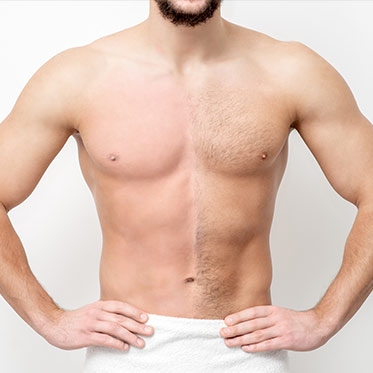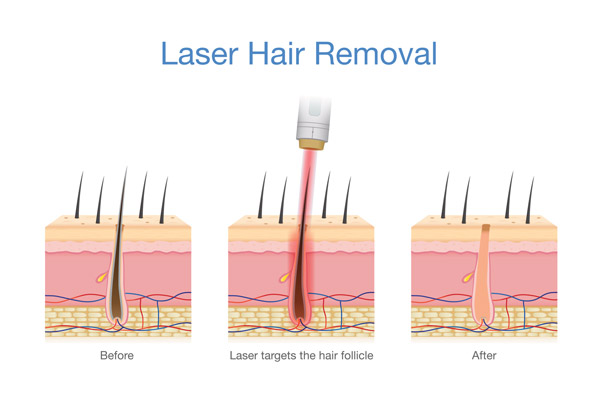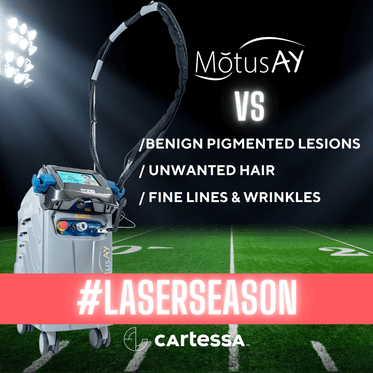Male Hair Removal

IMPORTANT INFORMATION ABOUT HAIR REMOVAL FOR MEN
Table of Contents
When did men start shaving body hair?
When did the straight razor get invented?
Is hair removal a historical trend for men?
Why would a man shave his body hair?
What phases of hair growth are there?
Shaving to get rid of hair.
Waxing to remove hair.
Using sugaring to remove hair.
How does laser hair removal work?
How many hair removal sessions will I need?
What is the best treatment for painless male hair removal?

When did men start shaving body hair? – Historical Perspective
Some love it, some hate it – male body hair! Men have been grooming body hair for thousands of years.
In ancient Egypt men serving in armies cut off all their body hair as it provided a means for the enemy to grab onto during battles.
Hair removal for men was not just for warriors, many used it as a nobility status symbol.
The Egyptians helped bring forward in essence the first Med Spas including grooming for men and women. They invented primitive forms of waxing, a mixture of sugar and beeswax. They also experimented with and popularized the first cosmetic ideas and items, including wigs, toothpaste, eye makeup, and the eradication of all body hair.
When did the straight razor get invented? The Razor’s Ascent
For thousands of years, not much changed for grooming until the turn of the century when “the straight razor” was invented and manufactured in England.
Soon after, a variety of shaving aids, including mugs, discs of firm soap, and gadgets for creating a creamy lather, appeared to assist men’s newly discovered shaving habits.
Even before the Egyptians, Neanderthals were starting to groom using sharpened seashells … ouch!
Is hair removal a historical trend for men? Changing Styles – Love/Hate Relationships with Hair
Hair on, hair off for men has been a complex culture of what’s in and what not.
 For those of you who know a little about Hollywood history, the late movie star Burt Reynolds was idolized for his hairy body, in fact so much that he posed as a centerfold in Playboy magazine.
For those of you who know a little about Hollywood history, the late movie star Burt Reynolds was idolized for his hairy body, in fact so much that he posed as a centerfold in Playboy magazine.
In that time era between the 1960s and 1970s hair was a BIG thing! During that era, women stopped shaving armpits and legs while men embraced a hairy chest even if they only had one, long hair.
Free-range body hair went out of style in the 1980s with the decline of the hippie movement.
In the 1990s–2000s, the “Brazilian” was born in NYC offered by immigrant sisters from Brazil. This waxing treatment became a huge hit. Men were starting to get more comfortable with cosmetic grooming, less hair and softer skin. This led to a twist on the name Brazilian to become the “Boyzilian” for men.
The term “manscaping” began to take hold at the beginning of the 21st century.
Over the past two decades and beyond “manscaping” has become widely used by millions of men to help sculpt themselves.
Why Would a Man Shave Hair off His Body Hair?
The last few decades have shown trends for men that want to remove hair on parts or the whole of their body for many reasons.
- Sports – Swimmers, joggers, bicyclists, bodybuilders, divers, runners, triathletes, and football players all have reason to minimize hair. Athletes shave their legs to improve muscle definition, lessen drag, hasten wound healing, and for aesthetic reasons.
- Aesthetics/Trends – As listed in our history section hair trends change with time. Current trends show males wanting hair removal for personal grooming reasons. Some prefer a thinning out, some complete removal.
- Ingrown Hairs – Beyond Aesthetics and sports, men simply want an easier way to shave, especially if they have ingrown hair.
- Sexual Preferences – Your significant other may prefer the clean smooth sensation of pure skin under their touch.
- PFD, or pseudofolliculitis barbae, is a disorder that can only be adequately treated by laser. Shaving can cause clusters of inflammatory, red, or black pimples to develop around hair follicles. Where a hair has grown back into the skin, ingrown hairs form red, frequently irritating lumps. Most of the time, you won’t need to see a doctor or expert for treatment because there are things you can do to manage and prevent them. Essentially, they are ingrown hairs that can create scars and grow in a variety of orientations.
What phases of hair growth are there?
There are many similarities between hair and skin. The multi-layered flat cells that make up skin and hair also provide the hair shaft with its structure and strength. Have you ever wondered why certain areas of our bodies only have hair growing there? Human hair is found almost everywhere on the body, with the exception of the eyelids, lips, palms of the hands, and soles of the feet.
Like skin, hair has a distinct growth cycle that it adheres to throughout its existence. The three separate and running phases of anagen, catagen, and telogen make up this structure. While one strand of hair may be in the anagen phase, another may be in the catagen phase since each hair follicle is totally independent of the others. Our hair does not come out in clumps because of this procedure. Very precise traits that are distinct to each phase also affect hair length.
 Shaving to Get Rid of Hair
Shaving to Get Rid of Hair
Both men and women who desire to get rid of extra hair can benefit from shaving. It can be used to get rid of hair from large or tiny areas, including the bikini line, pubic region, legs, arms, underarms, moustache, beard, and eyebrows. Straight razors and safety razors are used for “manual shaving” or “wet shaving,” whereas electric razors or beard trimmers are used for “dry shaving”.
A normal razor can produce a closer, more precise shave than an electric one, while also being quick and handy. Shaving with a conventional razor has a few guidelines to follow, even though using an electric razor is rather simple (simply switch it on and slide it over your face). To moisturize hairs, enhance razor glide, and reduce irritation, apply a shaving gel or foam, suds it up, and spread it all over. Find out more about shaving cream’s benefits and the distinctions between shave gels and foams here.
When you use a razor to remove hair that is clearly visible on your skin, you are only cutting it off near to its growth point. Shaving might aggravate the hair follicles that are still growing hair beneath the surface of your skin. This inflammation is what causes the itching you experience after shaving.
Waxing to Remove Hair
Waxing is a method that should be taken into consideration if you want to get rid of unwanted hair on your neck, legs, arms, or underarms. It is feasible to remove hair around the genitals, however, the procedure is extremely uncomfortable.
Waxing is obviously not a simple procedure, and discomfort will almost certainly always be involved. If you have a very low pain threshold, you might want to compare the benefits and drawbacks of waxing with those of alternative hair removal techniques. Or, if waxing seems appealing to you, you may get ready by reading tips for your initial wax to make sure everything goes as smoothly as possible.
 Using Sugaring to Remove Hair
Using Sugaring to Remove Hair
Sugaring, as opposed to waxing, just removes hairs, leaving the skin’s surface undisturbed. Hot wax clings to the skin and hair, removing skin cells along with it. This is not only uncomfortable but can also result in redness, swelling, inflammation, and even bruising. Additionally, if the wax is overly hot, it may burn your skin, particularly in delicate places. Since the paste only adheres to the hair and not the skin, sugaring is a more gentle form of hair removal. By doing this, the degree of pain and irritation to the area during the procedure is reduced. Additionally, the sugar paste’s malleability makes it easier to reach the root than hard wax. This reduces the likelihood of surface hair breakage.
How does Laser Hair Removal Work?
As many recognize, laser hair removal is one of the most common cosmetic laser procedures. In general, devices for hair removal beam highly concentrated light into hair follicles. Pigment in the follicles absorbs the light which then destroys the hair. The most efficacious laser for hair removal (particularly fine and light hair) has historically been the Alexandrite laser. However, limitations when treating darker skin types kept it from being the universal choice for providers and many patients have had to settle for less efficacious laser hair removal options. Until now, the Motus AY is the first, high-speed Alexandrite laser that makes it possible for even darker skin types to benefit from the effectiveness of this laser type. This breakthrough is possible because of Moveo technology — a handpiece that delivers fast, more efficient energy to destroy the hair in a way that is painless and free from side effects.
How many hair removal sessions will I need?
The number of sessions required to eliminate hair completely depends on the individual. A typical laser hair removal regimen is 6-12 sessions spaced one month apart and then maintenance treatments as needed. Given the efficacy of the Motus AY, you may need fewer sessions and could go longer before needing a touch-up treatment.

What is The Best Treatment for Painless Male Hair Removal?
Motus AY Hair Removal
 Gravity Med Spa is proud to offer laser hair removal, unlike any other laser treatment available. With our patients’ needs in mind, we conducted extensive research which led us to the Motus AY, distributed by Cartessa Aesthetics and manufactured by Europe’s top aesthetic laser manufacturer, DEKA.
Gravity Med Spa is proud to offer laser hair removal, unlike any other laser treatment available. With our patients’ needs in mind, we conducted extensive research which led us to the Motus AY, distributed by Cartessa Aesthetics and manufactured by Europe’s top aesthetic laser manufacturer, DEKA.
Here are the important facts you need to know about our Motus AY laser:
- Faster Hair Removal
- Fewer Treatments compared to typical laser hair removal
- Treat Light & Dark Skin-types
- More Comfortable Treatments
One of the major benefits of the Motus AY is that the Moveo technology eliminates the discomfort of typical laser hair removal. Most people only feel a warming sensation making the experience a highly comfortable one. How long will my treatment take? Treatment length will vary depending on the area being treated. The Motus AY is relatively fast and able to complete a large area in under 15 minutes.
Packages and Maintenance Plans
Attaining and maintaining your hair reduction is very important. We have various maintenance plans and even a membership program to help minimize irregularity in your laser hair reduction program. The membership program is cost-effective and can allow you to set your hair reduction program on automatic monthly payment while also providing you with regular calendar reminders to help better drive results. For more information on our laser hair removal membership, please call our office at 949-387-6118.
Ready for the Next Step?
The best way to determine whether Motus AY hair removal is right for you is to speak with an experienced medical provider. Call 949-387-6118 to schedule a free consultation at Gravity Med Spa. Dr. Boudreaux will help you explore your body hair removal options and customize a treatment plan that is unique to you. We’re excited to show you the shape of things to come.
